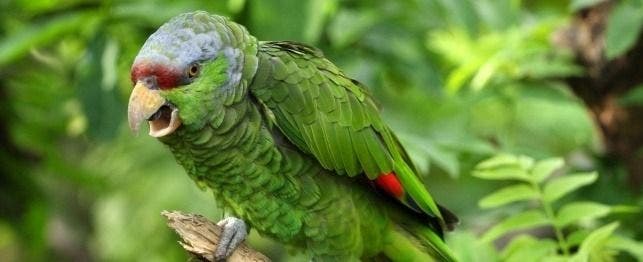
Choosing a Lilac-crowned Amazon
The intelligent, inquisitive lilac-crowned Amazons make good pets if you can get them. Unfortunately, these birds are rare in captivity and as pets. Also known as Finsch’s parrots, they are native to the Pacific slopes of Mexico. Lilac-crowned Amazons can probably live up to 50 years or more. Little is known about their life span in captivity.
Appearance and Personality
Lilac-crowned Amazons (Amazona finschi) are stocky green Amazons which resemble Mexican red-headed Amazons but their colors are not so vivid. The forehead is a maroon color and the crown is violet-blue and extends down back of neck. Cheeks are bright green. The beak is pale horn color. There is a prominent red speculum in the wing. Primary and secondary flight feathers are green with blue tips. Tail feathers green with yellowish green tips.
These birds have moderate speaking ability. Mature birds, especially males, may become aggressive. Lilac-crowned Amazons should always be provided with toys, blocks of wood or branches that they can chew. In order to ensure safety companion Amazons should not be allowed unsupervised freedom in the home as they often encounter toxins or dangerous items. Young Amazons should be socialized to many people and exposed to a variety of situations such as new cages, toys, visits to the veterinarian, handling by friends, wing and nail clips, etc. to avoid fear of novel situations. They need to have some space for exercise.
Feeding
Amazons should be fed a formulated (pelleted or extruded) diet as a basis for good nutrition. The pink eye ring subspecies should be fed a restricted diet to prevent obesity. The diet should be supplemented with fresh fruits and vegetables daily to add variety and psychological enrichment. Feed approximately 1/4 cup of pellets and 1/4 cup of fresh fruits and vegetables daily. Monitor food intake. Overfeeding leads to pickiness, selective feeding and wasteful throwing of food. Because of their tendency to obesity, lilac-crowned Amazons should be fed no sunflower or safflower seeds or seeds should only be given as treats. Vitamin supplements are not needed for birds that are eating a formulated diet.
Grooming
Routine bathing or showering is vital to maintaining good plumage and skin condition. Birds can be misted and allowed to dry in a warm room or in the sun, or gently dried with a blow drier. Care should be taken not to clip the wing feathers excessively as Amazons often fall and injure themselves. Clip only the primary flight feathers and only enough so the bird will glide to the floor. Lilac-crowned Amazons are heavy bodied and care must be taken not to cut too many feathers. Excessive wing clipping can result in injuries from falling.
Housing
Lilac-crowned Amazons are very active and should be provided the largest cage that space and budget allows. They should also be supplied with a retreat to guard against insecurity and fear responses. Ideally the cage should provide room for flight. Durable cage construction is not as critical as it is for macaws and cockatoos. Locks or escape proof latches may be necessary on cages. Ideally the bird will have an outdoor cage as well to allow playtime in the fresh-air and sunlight.
Breeding
Lilac-crowned Amazons are relatively more difficult to breed in captivity than most Amazons. They are shy by nature and need privacy. In North America, lilac-crowned Amazons breed predominantly in the spring and have a limited breeding season typically from February or March to June or July. Clutch size is typically 3 to 4 eggs. One inch by one inch by 14 gauge welded wire, or 1 inch by 1 inch welded wire is a good choice for cage construction. A suggested size is 4 feet wide by 4 feet tall by 8 feet long suspended 4 feet above the ground or floor.
Wooden nest boxes approximately 12 inches by 12 inches by 24 inches can be used.
Incubation period is approximately 24 to 26 days. Chicks will usually fledge at approximately 10 to 12 weeks of age. Lilac-crowned Amazons are relatively easy to hand-rear. Most hand rearing formulas can be used successfully.
Male lilac crowns are occasionally aggressive toward their mates. Clipping the wings of the male prior to the breeding season may be necessary in aggressive individuals to help the female to escape in case the male becomes aggressive. Males in breeding condition can be very aggressive to keepers.
Lilac crowns can be noisy when in breeding condition. When breeding Amazons, noise and proximity to neighbors must be considered.
Common Diseases and Disorders
Amazons are relatively healthy birds but are susceptible to the following:
- Feather picking
- Psittacosis
- Poor eating habits
- Bacterial and fungal infections
- Toxicity, ingestion of metals
- Toe necrosis
- Obesity